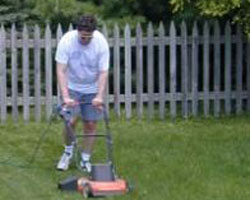When It’s Too Wet to Mow the Lawn
May 27, 2015
 MANHATTAN, Kan. – A series of weather systems that dumped rain across the heartland this spring have posed a dilemma for homeowners – what to do when the lawn hasn’t been cut in awhile because of wet weather?
MANHATTAN, Kan. – A series of weather systems that dumped rain across the heartland this spring have posed a dilemma for homeowners – what to do when the lawn hasn’t been cut in awhile because of wet weather?
“It’s best to set your mower as high as possible and bring it down in steps,” said Ward Upham, coordinator of Kansas State University’s horticulture rapid response center. “It is always best never to take more than one third of the grass blade off at any one time.”
If more is taken off, the plant reacts by using stored energy reserves to quickly send up new growth, he said. This reduces the amount of energy available for the plant to deal with stress or insect or disease damage.
“Sometimes, however, it is just not possible to keep the ‘one-third rule.’ In such cases, cut as high as
possible even though it may mean you are cutting off more than one third of the blade,” he said. “Bring the height down gradually by cutting more often and at progressively lower heights until you reach the target height.”
Upham is also coordinator of the K-State Research and Extension Master Gardener program. More information is available at Lawn and Garden.
-30-
Story by: Mary Lou Peter
mlpeter@ksu.edu
K-State Research & Extension News
Ward Upham - wupham@k-state.edu or 785-532-1438
